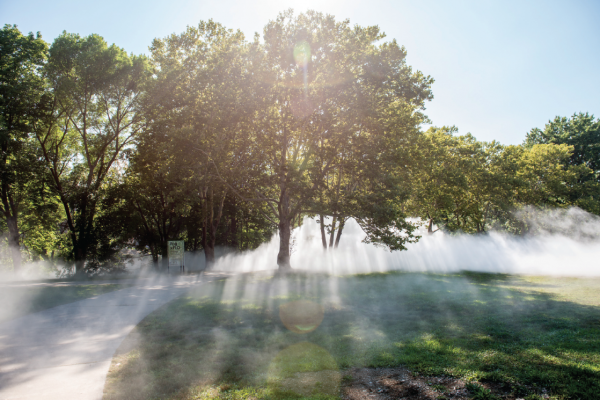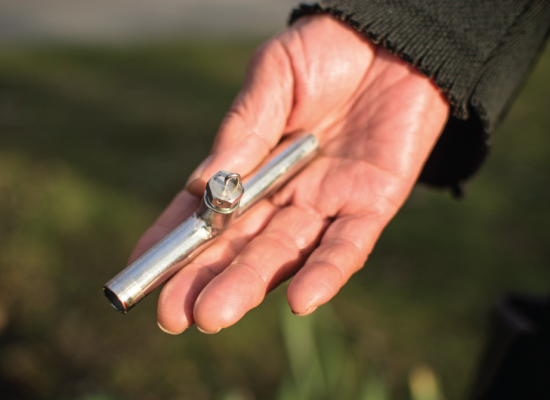Fog x FLO: Fujiko Nakaya

Fujiko Nakaya, Fog x FLO’s Fog x Canopy, Back Bay Fens, Boston, MA. Courtesy of Emerald Necklace Conservancy. Photo: Melissa Ostrow.
As the clock chimes the hour, a light mist starts to swirl. It builds quickly, silently, until… Whiteout. We hear shouts, laughter; up ahead, we see the faint outline of a hand…
On a steamy day in early August, the Japanese artist Fujiko Nakaya sat cradled in the arms of an old pine tree at the Arnold Arboretum, looking on serenely as her team made last-minute adjustments to her fog installation. The work is one of five scattered across Boston’s Emerald Necklace (the other sites are the Back Bay Fens, the Jamaica Pond beach, Leverett Pond and Franklin Park), commemorating the 20th anniversary of the Emerald Necklace Conservancy, and its efforts to nurture and draw attention to the sevenmile, 1,200-acre greenbelt designed by the eminent landscape architect Frederick Law Olmsted in the 1870s.
The commission is her first in Massachusetts and her second in New England—in 2014, she produced The Veil at the Philip Johnson Glass House in New Canaan, CT. The Conservancy hopes the works will help re-imprint on the cognitive map of Bostonians one of the city’s greatest treasures.
At 85, Nakaya has dreamed up foggy happenings across the globe, in landscapes as disparate as Australia and Wales, and for such prestigious institutions as the Tate Modern in London (London Fog #03779, 2017), the Centre Pompidou in Paris (Niagara Reverb #07150, 2017) and the Exploratorium in San Francisco (Fog Bridge, 2013). She welcomes collaboration, and has designed fog installations for theater, music and dance, including, notably, the Trisha Brown Dance Company (Opal Loop, New York, 1980).
As Nakaya tells it, her first fog studies were paintings, which gradually drifted into physical form. She considers her work to be sculptural in nature, and the land her canvas.
In the 1960s when she began approaching scientists and engineers in Japan to help devise an apparatus for making natural fog, the response was lukewarm. With chemical fog already available—used, primarily, to artificially cool turbines—few saw the advantage of producing a natural product. It was only when Nakaya joined the New York-based E.A.T. group (Experiments in Art and Technology—Robert Rauschenberg was a founding member), that she was able to connect with an engineer in California who developed what Nakaya fondly calls her fog nozzle. (The engineer went on to form Mee Industries Inc., now a multimillion-dollar natural fog maker for turbines, humidification and water treatment systems.) The minute opening at the center of the steel nozzle produces billions of fine water droplets per second, which in turn generates the fog.
Fujiko Nakaya’s fog nozzle. Courtesy of Emerald Necklace Conservatory
At the Arboretum, Nakaya and her team had strung four water hoses between two erect trees standing 12 feet apart. At an interval of three inches or so, a nozzle was connected along the hose. When the water flowed through, the nozzles generated the fog. Like a ready-made stage, the site seems primed for spectacle.
The exactitude of the process is at odds with the uncertainty of the form—shaped by the climate of the site—which Nakaya embraces, like a photographer discovering fresh details as his print develops.
In fact, Nakaya spends many weeks and months researching the landscape and climate of her intended site, even studying historical meteorological data to gauge temperature patterns. Wind is her biggest foe, and her chisel. Over time she has found ingenious ways to control the elements, including carving recesses, or basins, in the earth beneath the nozzles to harbor the fog. For Opal Loop, which was staged indoors, Nakaya placed heat generators below the dance floor to evaporate the inevitable moisture. (A fear of outcropping mushrooms was voiced at the Arboretum site that day.)
In preparation for her works along the Emerald Necklace, Nakaya also sought out the Olmsted archives, housed at Fairsted in Brookline, where the designer lived and worked. She says she admires his desire to cultivate wilderness as much as forge pathways, evident in his original plans for the parks. In the same vein, Nakaya defines her fog sculptures as articulated nature. She designs the course, but nature has the last word.

